The Influence of Virtual Forest Walk on Physiological and Psychological Responses
Abstract
:1. Introduction
2. Materials and Methods
2.1. Demographics
2.2. Study Site and Stimuli
2.2.1. Stress Induction Method
2.2.2. Design and Equipment
2.3. Measures
2.3.1. Physiological Index
2.3.2. Psychological Index
2.4. Experimental Procedure
2.5. Statistical Analysis
3. Results
3.1. Physiological Response to Virtual Environments
3.2. Psychological Response to Virtual Environments
4. Discussion
4.1. The Impact of Virtual Forest Walk on Physiological Responses
4.2. The Impact of Virtual Forest Walk on Psychological Responses
4.3. Limitations and Directions for Future Research
5. Conclusions
Author Contributions
Funding
Institutional Review Board Statement
Informed Consent Statement
Data Availability Statement
Conflicts of Interest
References
- Evans, G.; Cohen, S.; Stokols, D.; Altman, I. Handbook of Environmental Psychology; Wiley: Hoboken, NJ, USA, 1987. [Google Scholar]
- Lovallo, W.R.; Buchanan, T.W. Stress hormones in psychophysiological research: Emotional, behavioral, and cognitive implications. In Handbook of Psychophysiology; Cambridge University Press: Cambridge, UK, 2017. [Google Scholar]
- Van Dalfsen, J.H.; Markus, C.R. The influence of sleep on human hypothalamic–pituitary–adrenal (HPA) axis reactivity: A systematic review. Sleep Med. Rev. 2018, 39, 187–194. [Google Scholar] [CrossRef]
- Ushakov, V.A.; Ivanchenko, S.V.; Gagarina, A.A. Psychological stress in pathogenesis of essential hypertension. Curr. Hypertens. Rev. 2016, 12, 203–214. [Google Scholar] [CrossRef]
- Berto, R. The role of nature in coping with psycho-physiological stress: A literature review on restorativeness. Behav. Sci. 2014, 4, 394–409. [Google Scholar] [CrossRef] [PubMed]
- Alyan, E.; Saad, N.M.; Kamel, N.; Rahman, M.A. Workplace design-related stress effects on prefrontal cortex connectivity and neurovascular coupling. Appl. Ergon. 2021, 96, 103497. [Google Scholar] [CrossRef]
- Alyan, E.; Saad, N.M.; Kamel, N. Effects of Workstation Type on Mental Stress: fNIRS Study. Hum. Factors 2020, 0018720820913173. [Google Scholar] [CrossRef] [PubMed]
- White, H.; Shah, P. Attention in Urban and Natural Environments. Yale J. Biol. Med. 2019, 92, 115–120. [Google Scholar] [PubMed]
- Ulrich, R.S.; Simons, R.F.; Losito, B.D.; Fiorito, E.; Miles, M.A.; Zelson, M. Stress recovery during exposure to natural and urban environments. J. Environ. Psychol. 1991, 11, 201–230. [Google Scholar] [CrossRef]
- Bielinis, E.; Takayama, N.; Boiko, S.; Omelan, A.; Bielinis, L. The effect of winter forest bathing on psychological relaxation of young Polish adults. Urban For. Urban Green. 2018, 29, 276–283. [Google Scholar] [CrossRef]
- Yu, C.-P.; Lee, H.-Y.; Luo, X.-Y. The effect of virtual reality forest and urban environments on physiological and psychological responses. Urban For. Urban Green. 2018, 35, 106–114. [Google Scholar] [CrossRef]
- Song, C.; Ikei, H.; Kobayashi, M.; Miura, T.; Li, Q.; Kagawa, T.; Kumeda, S.; Imai, M.; Miyazaki, Y. Effects of viewing forest landscape on middle-aged hypertensive men. Urban For. Urban Green. 2017, 21, 247–252. [Google Scholar] [CrossRef]
- Ochiai, H.; Ikei, H.; Song, C.; Kobayashi, M.; Takamatsu, A.; Miura, T.; Kagawa, T.; Li, Q.; Kumeda, S.; Imai, M. Physiological and psychological effects of forest therapy on middle-aged males with high-normal blood pressure. Int. J. Environ. Res. Public Health 2015, 12, 2532–2542. [Google Scholar] [CrossRef]
- Song, C.; Ikei, H.; Miyazaki, Y. Physiological effects of nature therapy: A review of the research in Japan. Int. J. Environ. Res. Public Health 2016, 13, 781. [Google Scholar] [CrossRef] [PubMed]
- Stigsdotter, U.K.; Corazon, S.S.; Sidenius, U.; Kristiansen, J.; Grahn, P. It is not all bad for the grey city–A crossover study on physiological and psychological restoration in a forest and an urban environment. Health Place 2017, 46, 145–154. [Google Scholar] [CrossRef]
- Annerstedt, M.; Jönsson, P.; Wallergård, M.; Johansson, G.; Karlson, B.; Grahn, P.; Hansen, Å.M.; Währborg, P. Inducing physiological stress recovery with sounds of nature in a virtual reality forest—Results from a pilot study. Physiol. Behav. 2013, 118, 240–250. [Google Scholar] [CrossRef]
- Tomao, A.; Secondi, L.; Carrus, G.; Corona, P.; Portoghesi, L.; Agrimi, M. Restorative urban forests: Exploring the relationships between forest stand structure, perceived restorativeness and benefits gained by visitors to coastal Pinus pinea forests. Ecol. Indic. 2018, 90, 594–605. [Google Scholar] [CrossRef]
- Korpela, K.; Savonen, E.-M.; Anttila, S.; Pasanen, T.; Ratcliffe, E. Enhancing wellbeing with psychological tasks along forest trails. Urban For. Urban Green. 2017, 26, 25–30. [Google Scholar] [CrossRef]
- Tsunetsugu, Y.; Lee, J.; Park, B.-J.; Tyrväinen, L.; Kagawa, T.; Miyazaki, Y. Physiological and psychological effects of viewing urban forest landscapes assessed by multiple measurements. Landsc. Urban Plan. 2013, 113, 90–93. [Google Scholar] [CrossRef]
- Hansen, M.M.; Jones, R.; Tocchini, K. Shinrin-Yoku (Forest Bathing) and Nature Therapy: A State-of-the-Art Review. Int. J. Environ. Res. Public Health 2017, 14, 851. [Google Scholar] [CrossRef]
- Chae, Y.; Lee, S.; Jo, Y.; Kang, S.; Park, S.; Kang, H. The Effects of Forest Therapy on Immune Function. Int. J. Environ. Res. Public Health 2021, 18, 8440. [Google Scholar] [CrossRef] [PubMed]
- Smith, J.W. Immersive virtual environment technology to supplement environmental perception, preference and behavior research: A review with applications. Int. J. Environ. Res. Public Health 2015, 12, 11486–11505. [Google Scholar] [CrossRef]
- Cieślik, B.; Mazurek, J.; Rutkowski, S.; Kiper, P.; Turolla, A.; Szczepańska-Gieracha, J. Virtual reality in psychiatric disorders: A systematic review of reviews. Complement. Ther. Med. 2020, 52, 102480. [Google Scholar] [CrossRef] [PubMed]
- Wang, X.; Shi, Y.; Zhang, B.; Chiang, Y. The Influence of Forest Resting Environments on Stress Using Virtual Reality. Int. J. Environ. Res. Public Health 2019, 16, 3263. [Google Scholar] [CrossRef]
- Ahmadpour, N.; Keep, M.; Janssen, A.; Rouf, A.S.; Marthick, M. Design strategies for virtual reality interventions for managing pain and anxiety in children and adolescents: Scoping review. JMIR Serious Games 2020, 8, e14565. [Google Scholar] [CrossRef]
- Wechsler, T.F.; Kümpers, F.; Mühlberger, A. Inferiority or even superiority of virtual reality exposure therapy in phobias?—A systematic review and quantitative meta-analysis on randomized controlled trials specifically comparing the efficacy of virtual reality exposure to gold standard in vivo exposure in agoraphobia, specific phobia, and social phobia. Front. Psychol. 2019, 10, 1758. [Google Scholar]
- Park, M.J.; Kim, D.J.; Lee, U.; Na, E.J.; Jeon, H.J. A literature overview of virtual reality (VR) in treatment of psychiatric disorders: Recent advances and limitations. Front. Psychiatry 2019, 10, 505. [Google Scholar] [CrossRef]
- Reese, G.; Kohler, E.; Menzel, C. Restore or get restored: The effect of control on stress reduction and restoration in virtual nature settings. Sustainability 2021, 13, 1995. [Google Scholar] [CrossRef]
- Huang, Q.; Yang, M.; Jane, H.A.; Li, S.; Bauer, N. Trees, grass, or concrete? The effects of different types of environments on stress reduction. Landsc. Urban Plan. 2020, 193, 103654. [Google Scholar] [CrossRef]
- Van ’t Wout, M.; Spofford, C.M.; Unger, W.S.; Sevin, E.B.; Shea, M.T. Skin Conductance Reactivity to Standardized Virtual Reality Combat Scenes in Veterans with PTSD. Appl. Psychophysiol. Biofeedback 2017, 42, 209–221. [Google Scholar] [CrossRef] [PubMed]
- Bari, D.S.; Aldosky, H.Y.Y.; Tronstad, C.; Martinsen, Ø.G. The correlations among the skin conductance features responding to physiological stress stimuli. Skin Res. Technol. 2021, 27, 582–588. [Google Scholar] [CrossRef] [PubMed]
- Lee, J.; Park, B.J.; Tsunetsugu, Y.; Ohira, T.; Kagawa, T.; Miyazaki, Y. Effect of forest bathing on physiological and psychological responses in young Japanese male subjects. Public Health 2011, 125, 93–100. [Google Scholar] [CrossRef]
- Gao, T.; Zhang, T.; Zhu, L.; Gao, Y.; Qiu, L. Exploring Psychophysiological Restoration and Individual Preference in the Different Environments Based on Virtual Reality. Int. J. Environ. Res. Public Health 2019, 16, 3102. [Google Scholar] [CrossRef]
- Hodapp, V.; Heiligtag, U.; Störmer, S.W. Cardiovascular reactivity, anxiety and anger during perceived controllability. Biol. Psychol. 1990, 30, 161–170. [Google Scholar] [CrossRef]
- Stemmler, G. Physiological processes during emotion. In The Regulation of Emotion; Psychology Press: Mahwah, NJ, USA, 2004; pp. 33–70. [Google Scholar]
- Yin, J.; Zhu, S.; MacNaughton, P.; Allen, J.G.; Spengler, J.D. Physiological and cognitive performance of exposure to biophilic indoor environment. Build. Environ. 2018, 132, 255–262. [Google Scholar] [CrossRef]
- Alvarsson, J.J.; Wiens, S.; Nilsson, M.E. Stress recovery during exposure to nature sound and environmental noise. Int. J. Environ. Res. Public Health 2010, 7, 1036–1046. [Google Scholar] [CrossRef]
- McNair, D.; Lorr, M.; Droppleman, L. Revised manual for the profile of mood states. S. Diego Educ. Ind. Test. Serv. 1992, 7, 732–733. [Google Scholar]
- Zhang, X.; Lian, Z.; Ding, Q. Investigation variance in human psychological responses to wooden indoor environments. Build. Environ. 2016, 109, 58–67. [Google Scholar] [CrossRef]
- Wang, X.; Zhu, H.; Shang, Z.; Chiang, Y. The influence of viewing photos of different types of rural landscapes on stress in Beijing. Sustainability 2019, 11, 2537. [Google Scholar] [CrossRef]
- Mitchell, R.; Popham, F. Effect of exposure to natural environment on health inequalities: An observational population study. Lancet 2008, 372, 1655–1660. [Google Scholar] [CrossRef]
- Czech, O.; Wrzeciono, A.; Rutkowska, A.; Guzik, A.; Kiper, P.; Rutkowski, S. Virtual Reality Interventions for Needle-Related Procedural Pain, Fear and Anxiety—A Systematic Review and Meta-Analysis. J. Clin. Med. 2021, 10, 3248. [Google Scholar] [CrossRef] [PubMed]
- Joung, D.; Kim, G.; Choi, Y.; Lim, H.; Park, S.; Woo, J.-M.; Park, B.-J. The prefrontal cortex activity and psychological effects of viewing forest landscapes in autumn season. Int. J. Environ. Res. Public Health 2015, 12, 7235–7243. [Google Scholar] [CrossRef]
- Herzog, T.R.; Black, A.M.; Fountaine, K.A.; Knotts, D.J. Reflection and attentional recovery as distinctive benefits of restorative environments. J. Environ. Psychol. 1997, 17, 165–170. [Google Scholar] [CrossRef]
- Rybråten, S.; Skår, M.; Nordh, H. The phenomenon of walking: Diverse and dynamic. Landsc. Res. 2019, 44, 62–74. [Google Scholar] [CrossRef]
- Barton, J.; Pretty, J. What is the best dose of nature and green exercise for improving mental health? A multi-study analysis. Environ. Sci. Technol. 2010, 44, 3947–3955. [Google Scholar] [CrossRef] [PubMed]
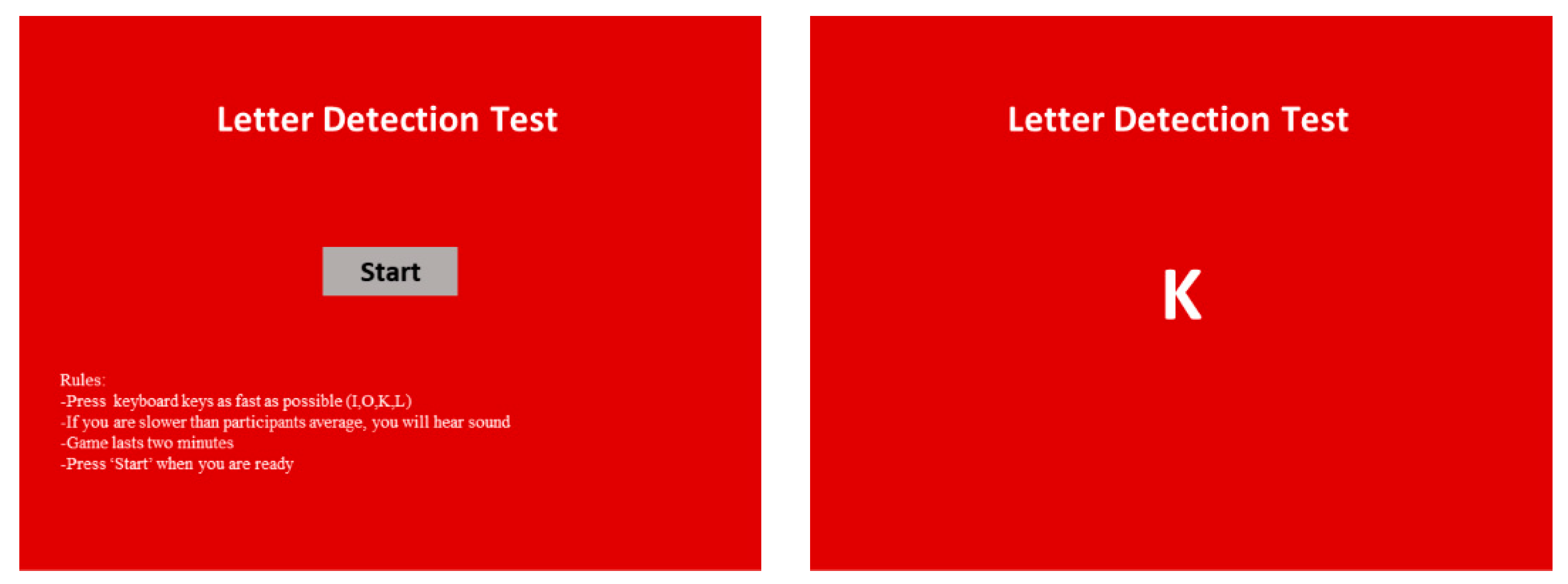
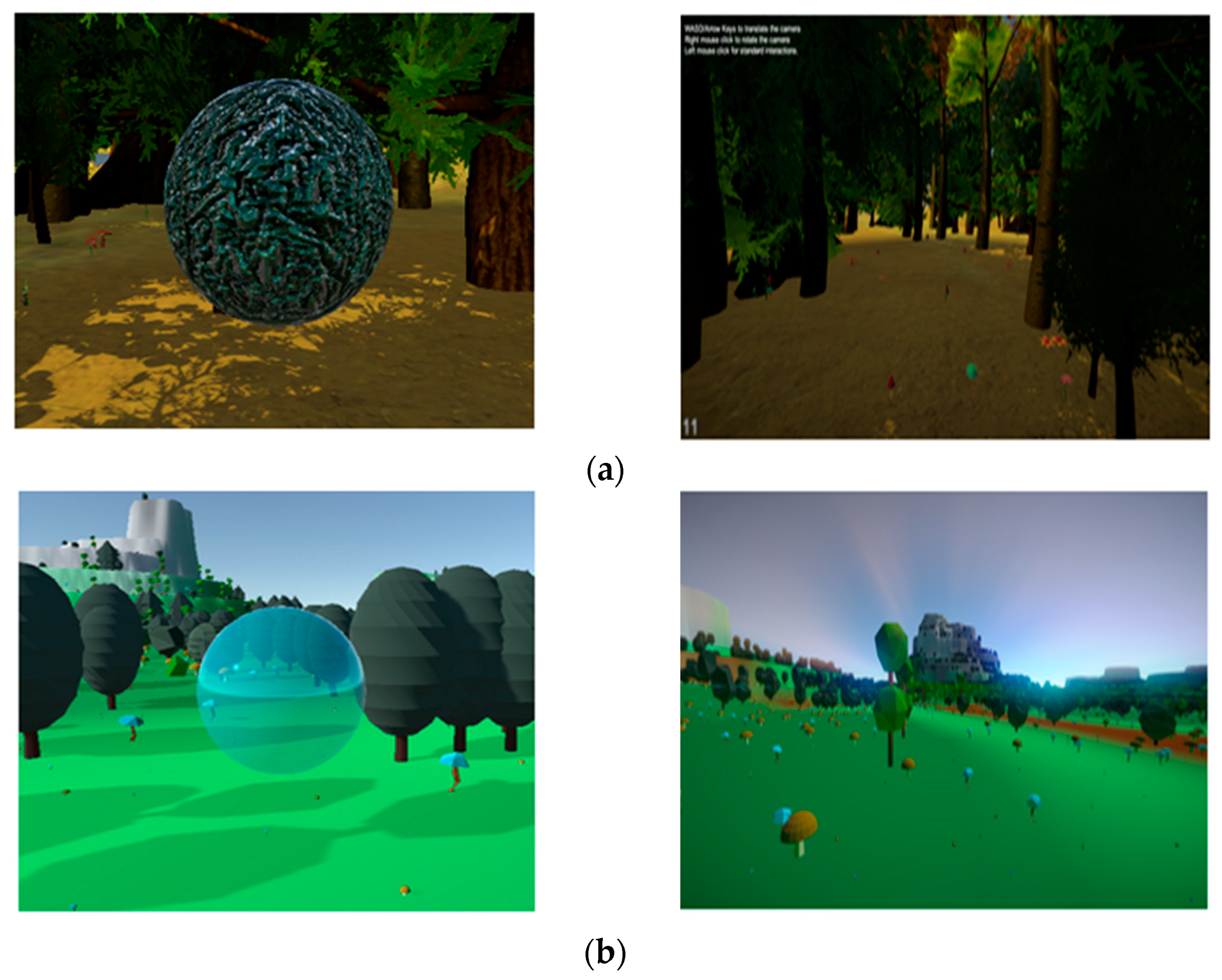
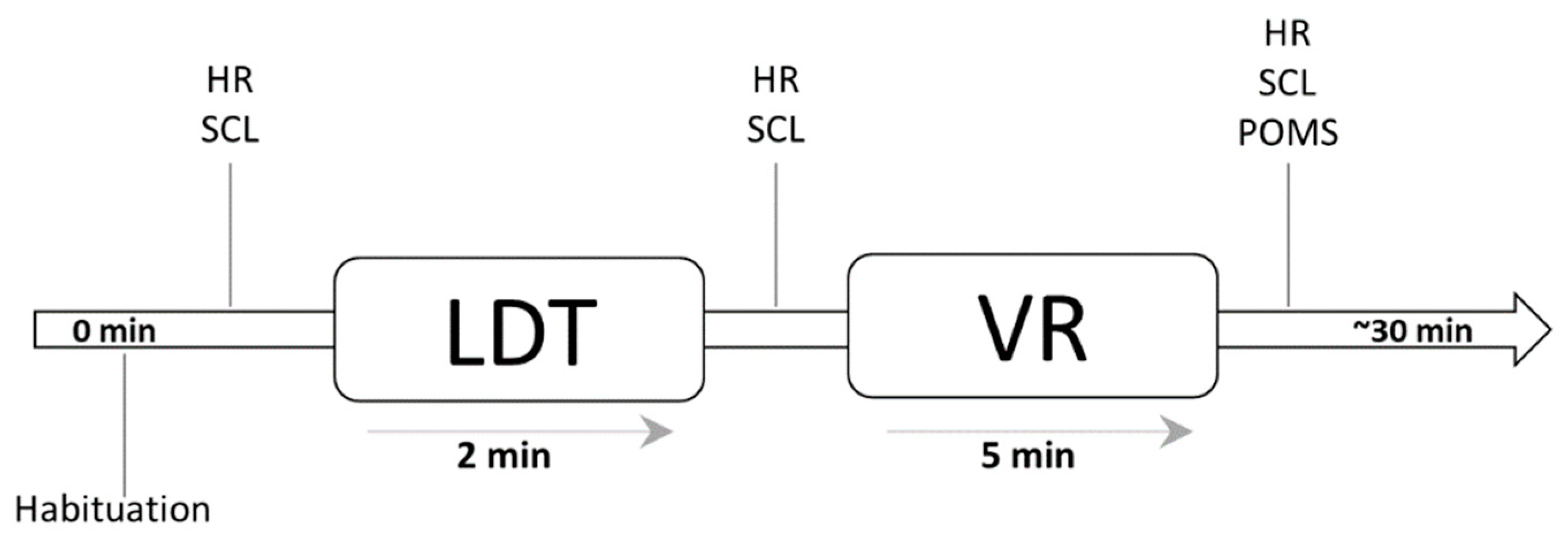
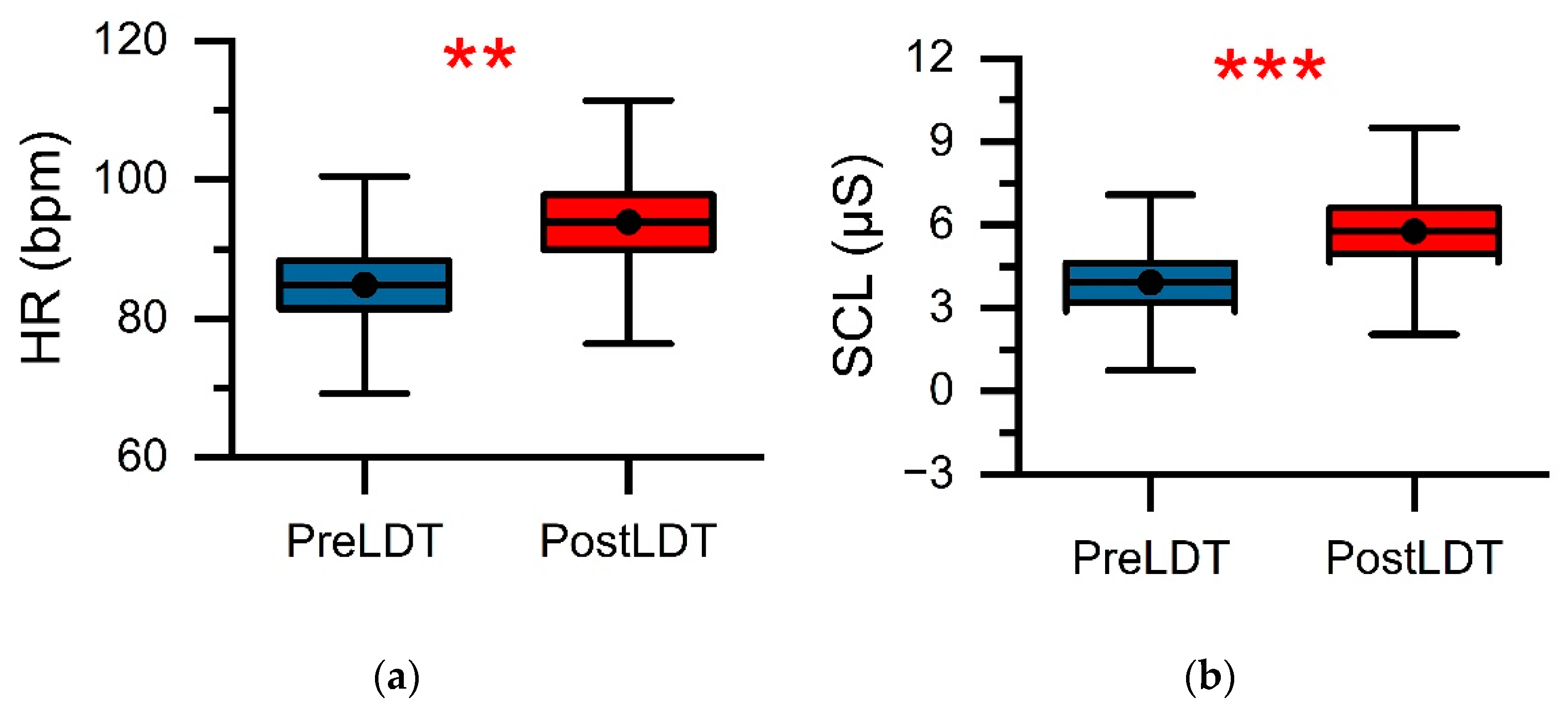
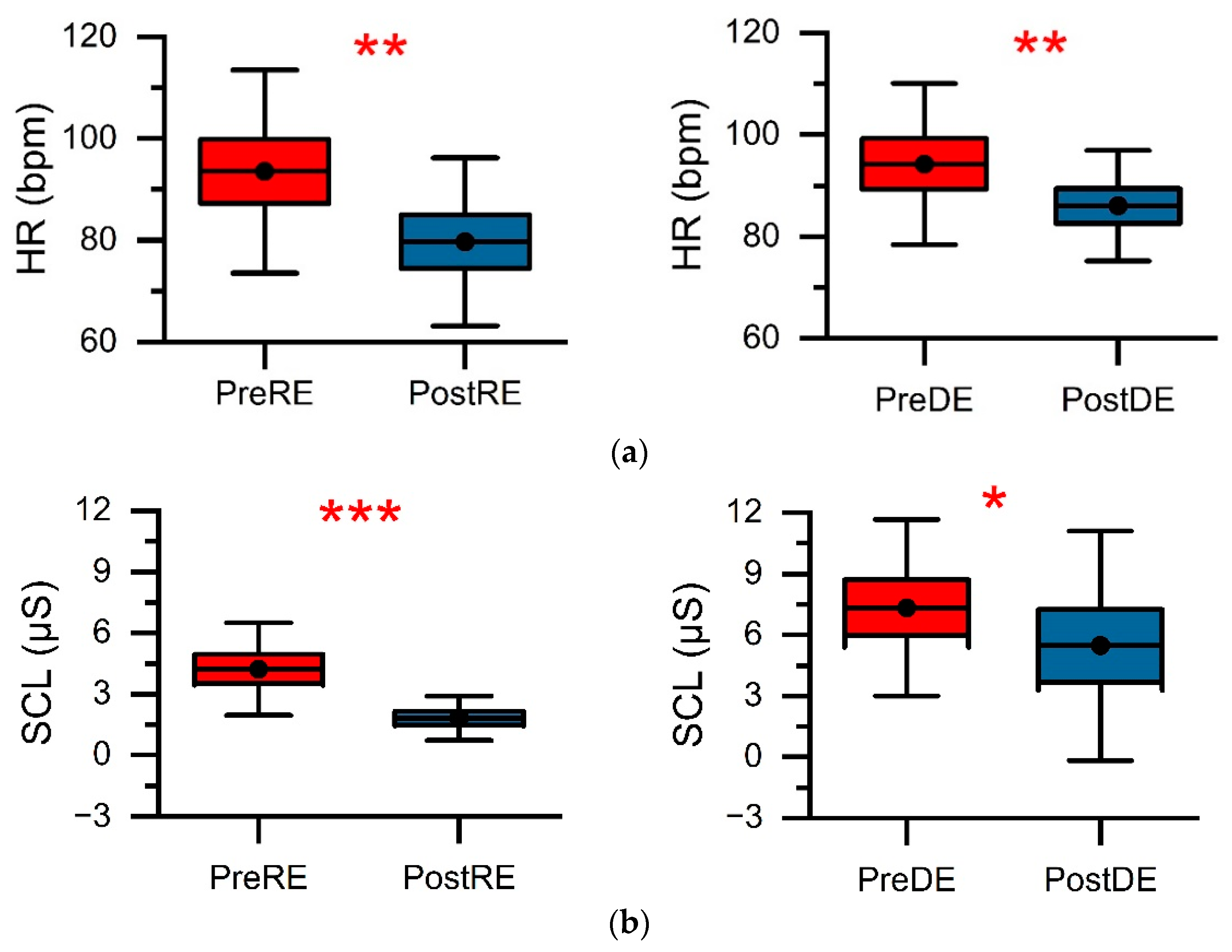

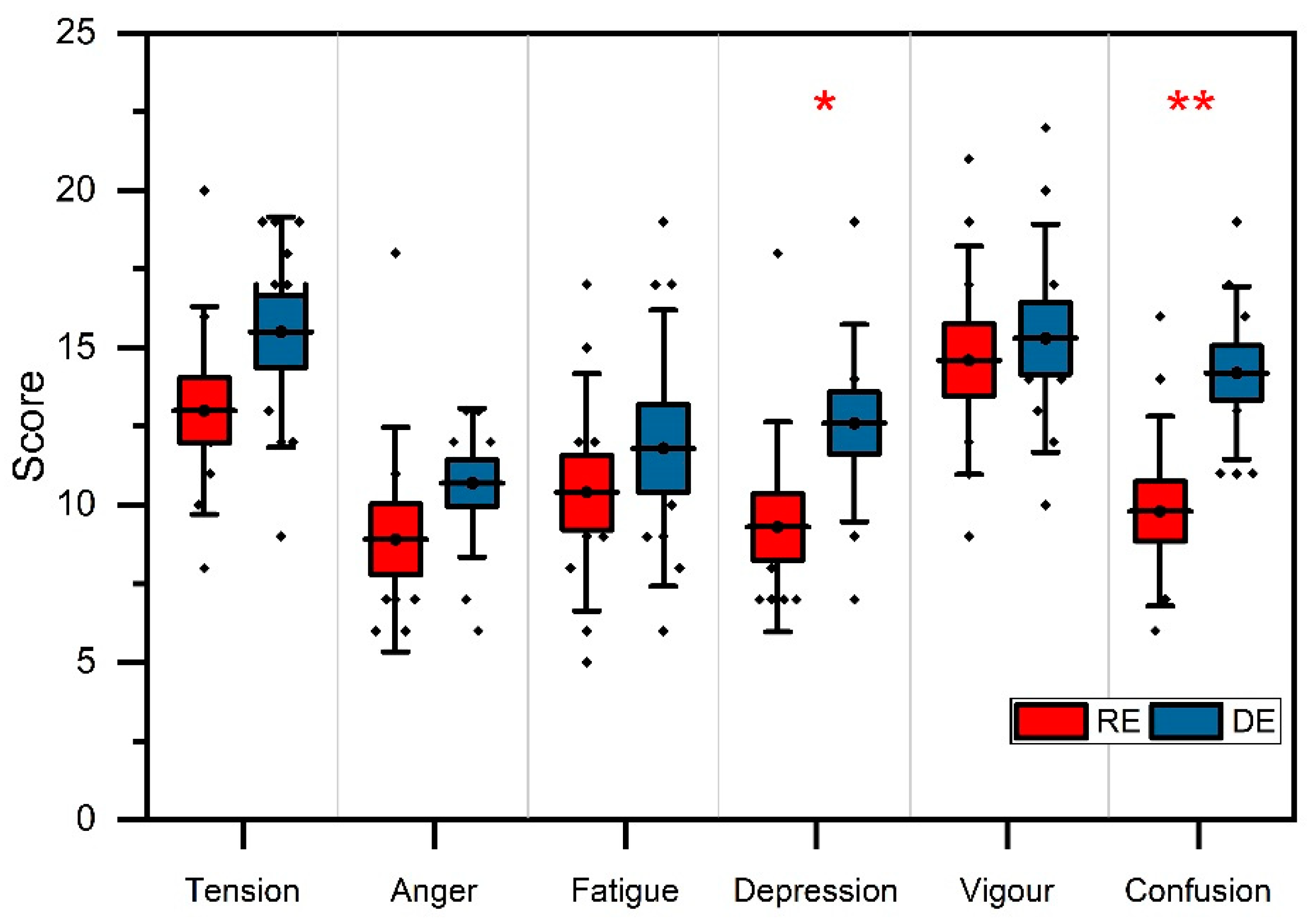
| Total Sample | ||
|---|---|---|
| RE | DE | |
| N | 10 | 10 |
| Gender | ||
| Male | 5 | 5 |
| Female | 5 | 5 |
| Age Group | ||
| 18–25 | 23 (1.1) | 20.6 (2.4) |
| Education | ||
| University Degree | 10 | 10 |
| Index | Pre | Post | Paired t-Test | ||||
|---|---|---|---|---|---|---|---|
| Mean | SD | Mean | SD | t-Value | p-Value | Cohen’s D | |
| HR | |||||||
| LDT | 84.9 | 15.6 | 93.9 | 17.5 | 3.5 | 0.001 ** | 0.54 |
| RE | 93.5 | 20.0 | 79.7 | 16.5 | 3.3 | 0.005 ** | 0.75 |
| DE | 94.2 | 15.8 | 86.0 | 10.8 | 3.1 | 0.006 ** | 0.59 |
| SCL | |||||||
| LDT | 3.9 | 3.2 | 5.8 | 3.7 | 7.3 | 0.000 *** | 0.55 |
| RE | 4.2 | 2.3 | 1.8 | 1.1 | 5.3 | 0.000 *** | 1.20 |
| DE | 7.3 | 4.3 | 5.5 | 5.6 | 2.5 | 0.016 * | 0.33 |
| VR | Mean | SD | Two-Sample t-Test | ||
|---|---|---|---|---|---|
| t-Value | p-Value | Cohen’s D | |||
| RE | 36.8 | 14.8 | 1.9 | 0.035 * | 0.86 |
| DE | 49.5 | 14.8 | |||
| POMS Subscale | RE | DE | One-Way ANOVA | ||||
|---|---|---|---|---|---|---|---|
| Mean | SD | Mean | SD | F-Value | p-Value | ηp2 | |
| Tension | 13.0 | 3.3 | 15.5 | 3.7 | 2.6 | 0.126 | 0.13 |
| Anger | 8.9 | 3.6 | 10.7 | 2.4 | 1.8 | 0.200 | 0.09 |
| Fatigue | 10.4 | 3.8 | 11.8 | 4.41 | 0.6 | 0.455 | 0.03 |
| Depression | 9.3 | 3.3 | 12.6 | 3.1 | 5.2 | 0.035 * | 0.22 |
| Vigor | 14.6 | 3.6 | 15.3 | 3.6 | 0.2 | 0.671 | 0.01 |
| Confusion | 9.8 | 3.0 | 14.2 | 2.7 | 11.7 | 0.003 ** | 0.39 |
Publisher’s Note: MDPI stays neutral with regard to jurisdictional claims in published maps and institutional affiliations. |
© 2021 by the authors. Licensee MDPI, Basel, Switzerland. This article is an open access article distributed under the terms and conditions of the Creative Commons Attribution (CC BY) license (https://creativecommons.org/licenses/by/4.0/).
Share and Cite
Alyan, E.; Combe, T.; Awang Rambli, D.R.; Sulaiman, S.; Merienne, F.; Muhaiyuddin, N.D.M. The Influence of Virtual Forest Walk on Physiological and Psychological Responses. Int. J. Environ. Res. Public Health 2021, 18, 11420. https://doi.org/10.3390/ijerph182111420
Alyan E, Combe T, Awang Rambli DR, Sulaiman S, Merienne F, Muhaiyuddin NDM. The Influence of Virtual Forest Walk on Physiological and Psychological Responses. International Journal of Environmental Research and Public Health. 2021; 18(21):11420. https://doi.org/10.3390/ijerph182111420
Chicago/Turabian StyleAlyan, Emad, Theo Combe, Dayang Rohaya Awang Rambli, Suziah Sulaiman, Frederic Merienne, and Nadia Diyana Mohd Muhaiyuddin. 2021. "The Influence of Virtual Forest Walk on Physiological and Psychological Responses" International Journal of Environmental Research and Public Health 18, no. 21: 11420. https://doi.org/10.3390/ijerph182111420
APA StyleAlyan, E., Combe, T., Awang Rambli, D. R., Sulaiman, S., Merienne, F., & Muhaiyuddin, N. D. M. (2021). The Influence of Virtual Forest Walk on Physiological and Psychological Responses. International Journal of Environmental Research and Public Health, 18(21), 11420. https://doi.org/10.3390/ijerph182111420








